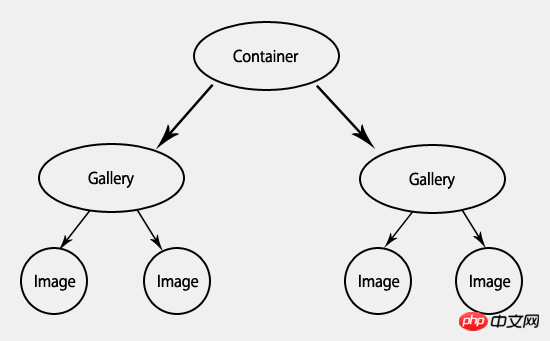
The combination pattern generally combines a series of similar small objects into a large object. This large object provides an interface to operate the small objects inside. Let's take a detailed look at the combination pattern in the design pattern. The use of
in JavaScript program construction
Definition
Composition, as the name suggests, refers to creating a single entity from objects containing multiple components. This single entity will serve as the access point for all of these parts, and while this greatly simplifies things, it can also be quite deceptive, as there is no implicit way of making it clear how many parts the combination contains.
The goal of the combination pattern is to decouple the client program from the internal architecture of complex elements so that the client program treats all sub-elements equally. Each child node can make complex existence. For the parent node, there is no need to know the complexity of the child node or the complexity of implementing the child node. You only need to pay attention to the specific methods of the child node and you can use it. child node. Simplified relationship between father and son.The same is true for child nodes. Excessive interface exposure is sometimes an abuse, and it also reduces external dependence.
Examples It is best to use examples to explain combinations. In the image below you can see two different types of objects: containers and libraries are compositions, and images are leaves. A composition can host children, but generally does not implement further behavior. Leaves contain most behaviors, but cannot host children, at least not in the traditional composition example.
It is best to use examples to explain combinations. In the image below you can see two different types of objects: containers and libraries are compositions, and images are leaves. A composition can host children, but generally does not implement further behavior. Leaves contain most behaviors, but cannot host children, at least not in the traditional composition example.
var GalleryComposite = function (heading, id) { this.children = []; this.element = $('') .append('' + heading + '
'); } GalleryComposite.prototype = { add: function (child) { this.children.push(child); this.element.append(child.getElement()); }, remove: function (child) { for (var node, i = 0; node = this.getChild(i); i++) { if (node == child) { this.children.splice(i, 1); this.element.detach(child.getElement()); return true; } if (node.remove(child)) { return true; } } return false; }, getChild: function (i) { return this.children[i]; }, hide: function () { for (var node, i = 0; node = this.getChild(i); i++) { node.hide(); } this.element.hide(0); }, show: function () { for (var node, i = 0; node = this.getChild(i); i++) { node.show(); } this.element.show(0); }, getElement: function () { return this.element; } }
var GalleryImage = function (src, id) { this.children = []; this.element = $('![]() ') .attr('id', id) .attr('src', src); } GalleryImage.prototype = { // Due to this being a leaf, it doesn't use these methods, // but must implement them to count as implementing the // Composite interface add: function () { }, remove: function () { }, getChild: function () { }, hide: function () { this.element.hide(0); }, show: function () { this.element.show(0); }, getElement: function () { return this.element; } }
') .attr('id', id) .attr('src', src); } GalleryImage.prototype = { // Due to this being a leaf, it doesn't use these methods, // but must implement them to count as implementing the // Composite interface add: function () { }, remove: function () { }, getChild: function () { }, hide: function () { this.element.hide(0); }, show: function () { this.element.show(0); }, getElement: function () { return this.element; } }
var container = new GalleryComposite('', 'allgalleries'); var gallery1 = new GalleryComposite('Gallery 1', 'gallery1'); var gallery2 = new GalleryComposite('Gallery 2', 'gallery2'); var image1 = new GalleryImage('image1.jpg', 'img1'); var image2 = new GalleryImage('image2.jpg', 'img2'); var image3 = new GalleryImage('image3.jpg', 'img3'); var image4 = new GalleryImage('image4.jpg', 'img4'); gallery1.add(image1); gallery1.add(image2); gallery2.add(image3); gallery2.add(image4); container.add(gallery1); container.add(gallery2); // Make sure to add the top container to the body, // otherwise it'll never show up. container.getElement().appendTo('body'); container.show();
Benefits of the combination mode:
Simple operations can also produce complex results. You only need to perform operations on the top-level object and let each sub-object pass the operation by itself. This is especially useful for operations that are performed over and over again. In the composite pattern, the coupling between various objects is very loose. As long as they implement the same interface then changing their location or swapping them is a breeze. This promotes code reuse and also facilitates code refactoring.Whenever an operation is performed on a top-level composite object, a depth-first search of the entire structure is performed to find nodes, and the programmer who created the composite object has no knowledge of these details. It is very easy to add, delete and find nodes in this hierarchy.
Disadvantages of the combination pattern:
The ease of use of the combination object may mask the cost of each operation it supports. Since any operation called by a composite object will be passed to all its child objects, if the hierarchy is large, the performance of the system will be affected. Proper operation of the composition pattern requires the use of some form of interface. When composite objects and node classes are used as packaging tools for HTML elements, the composite object must comply with the usage rules of HTML. For example, a table is difficult to convert into a composite object. The stricter the interface check, the more reliable the combined object class will be. The above is what I compiled for everyone. I hope it will be helpful to everyone in the future. ###Tutorial on using combination patterns in JavaScript design pattern development (advanced)######The above is the detailed content of The use of combination patterns in design patterns in JavaScript program construction (advanced). For more information, please follow other related articles on the PHP Chinese website!




